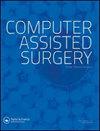Early postoperative efficacy of a fully automated orthopedic robotic system-assisted percutaneous pedicle screw fixation for isthmic spondylolisthesis.
IF 1.9
4区 医学
Q3 SURGERY
引用次数: 0
Abstract
To assess the feasibility of percutaneous pedicle screw fixation assisted by a fully automated orthopedic robotic system for the treatment of isthmic spondylolisthesis and evaluate its early postoperative outcome. Totally 20 patients with isthmic spondylolisthesis who underwent surgical procedure by the same medical group from March 2020 to March 2023 were retrospectively analyzed, including 10 patients in the robot-assisted group (RA group) and the other 10 patients in the conventional free-hand technique group (FH group). Accuracy of screw insertion was determined using the Gertzbein-Robbins Scale. The accuracy of the novel robotic system was evaluated by comparing the screw position in the preoperative planning and measuring the entry point deviation distance and the trajectory rotation. The differences in operative time, intraoperative blood loss, radiographic fluoroscopy time and fluoroscopic dosage, and length of hospital stay were compared between the two groups. The lumbar visual analog scale scores before and 7 days after operation were analyzed to evaluate the improvement of low back pain as the early postoperative outcome. A total of 84 pedicle screws were placed. In the RA group, 97.5% of screws were Grade A, and 2.5% were Grade B. In the FH group, 88.6% of screws were Grade A, 9.1% were Grade B, and 2.3% were Grade C. No statistical difference was found in the operation time between two groups. The RA group showed a significant reduction in intraoperative blood loss, radiographic fluoroscopy time and fluoroscopic dosage, and length of hospital stay compared to the FH group. The low back pain in both groups was significantly improved after the operation. The novel orthopedic robotic system-assisted percutaneous pedicle screw fixation, with accurate intraoperative screw placement, less surgical damage, less fluoroscopy and shorter length of hospital stay, can be safe and effective for the surgical treatment of isthmic spondylolisthesis.全自动骨科机器人系统辅助经皮椎弓根螺钉固定治疗峡部脊柱滑脱症的术后早期疗效。
目的:评估全自动骨科机器人系统辅助经皮椎弓根螺钉固定治疗峡部脊柱滑脱症的可行性,并评估其术后早期疗效。回顾性分析了2020年3月至2023年3月期间在同一医疗小组接受手术治疗的20例峡部性脊柱滑脱症患者,其中10例为机器人辅助组(RA组)患者,另外10例为传统徒手技术组(FH组)患者。使用 Gertzbein-Robbins 量表确定螺钉插入的准确性。通过比较术前计划中的螺钉位置、测量进入点偏离距离和轨迹旋转来评估新型机器人系统的准确性。比较了两组手术时间、术中失血量、放射透视时间和透视剂量以及住院时间的差异。分析了术前和术后 7 天的腰椎视觉模拟量表评分,以评估术后早期腰痛的改善情况。两组共植入了84枚椎弓根螺钉。在 RA 组中,97.5% 的螺钉为 A 级,2.5% 为 B 级;在 FH 组中,88.6% 的螺钉为 A 级,9.1% 为 B 级,2.3% 为 C 级。与 FH 组相比,RA 组在术中失血量、射线透视时间和透视剂量以及住院时间方面均明显减少。术后,两组患者的腰背痛均有明显改善。新型骨科机器人系统辅助经皮椎弓根螺钉固定术具有术中螺钉置入准确、手术损伤小、透视时间短、住院时间短等优点,可安全有效地用于峡部脊柱滑脱症的手术治疗。
本文章由计算机程序翻译,如有差异,请以英文原文为准。
求助全文
约1分钟内获得全文
求助全文
来源期刊

Computer Assisted Surgery
Medicine-Surgery
CiteScore
2.30
自引率
0.00%
发文量
13
审稿时长
10 weeks
期刊介绍:
omputer Assisted Surgery aims to improve patient care by advancing the utilization of computers during treatment; to evaluate the benefits and risks associated with the integration of advanced digital technologies into surgical practice; to disseminate clinical and basic research relevant to stereotactic surgery, minimal access surgery, endoscopy, and surgical robotics; to encourage interdisciplinary collaboration between engineers and physicians in developing new concepts and applications; to educate clinicians about the principles and techniques of computer assisted surgery and therapeutics; and to serve the international scientific community as a medium for the transfer of new information relating to theory, research, and practice in biomedical imaging and the surgical specialties.
The scope of Computer Assisted Surgery encompasses all fields within surgery, as well as biomedical imaging and instrumentation, and digital technology employed as an adjunct to imaging in diagnosis, therapeutics, and surgery. Topics featured include frameless as well as conventional stereotactic procedures, surgery guided by intraoperative ultrasound or magnetic resonance imaging, image guided focused irradiation, robotic surgery, and any therapeutic interventions performed with the use of digital imaging technology.
 求助内容:
求助内容: 应助结果提醒方式:
应助结果提醒方式:


